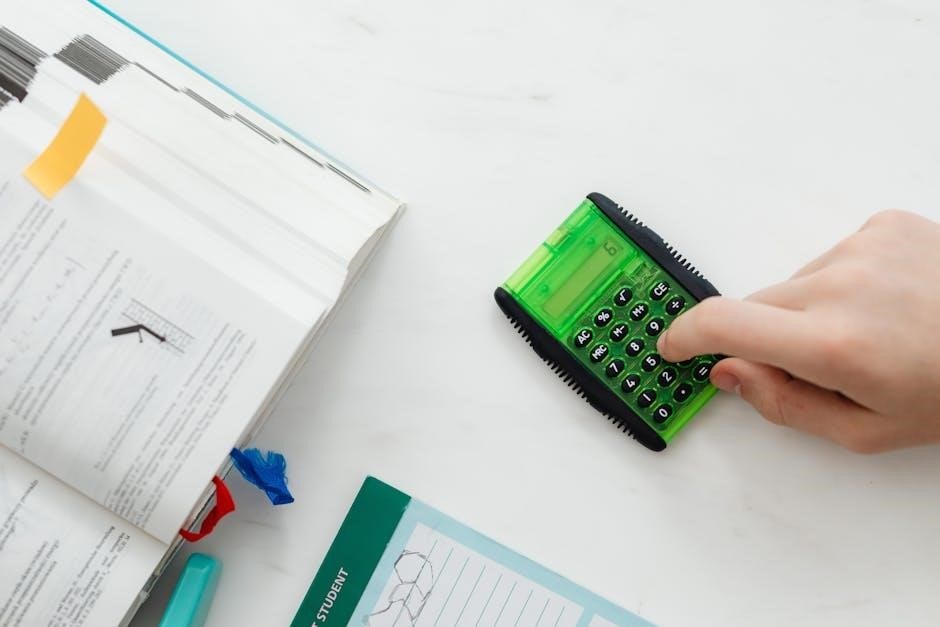Mastering the addition and subtraction of mixed numbers with like denominators is a fundamental skill in mathematics. Mixed numbers, which consist of a whole number and a fractional part, are essential in various real-world applications, such as cooking and measurements. Adding and subtracting these numbers requires a systematic approach, starting with aligning the whole numbers and fractions separately. By focusing on these steps, students can build confidence and accuracy in their calculations, ensuring a strong foundation for more complex mathematical concepts.
Definition of Mixed Numbers and Their Importance
Mixed numbers combine a whole number and a proper fraction, representing quantities greater than one whole but less than the next whole number. For example, 3½ is a mixed number. They are crucial in real-world math, such as cooking, construction, and measurements, where precise quantities are essential. Understanding mixed numbers enhances problem-solving skills and prepares students for advanced mathematical concepts. Their practical applications make them a cornerstone of foundational arithmetic.
Why Adding and Subtracting Mixed Numbers Is Essential in Math Education
Mastering the addition and subtraction of mixed numbers is a cornerstone of mathematical literacy, fostering problem-solving skills and logical thinking. These operations are vital for understanding real-world measurements, recipes, and financial calculations. By learning to manipulate mixed numbers, students develop a strong foundation for algebra and higher-level math. This skill also enhances accuracy in handling fractions, a critical component of STEM disciplines. Proficiency in adding and subtracting mixed numbers ensures confidence in tackling complex mathematical challenges effectively.

Step-by-Step Guide to Adding Mixed Numbers with Like Denominators
Adding mixed numbers with like denominators involves aligning whole numbers and fractions separately. Add the whole numbers first, then the fractional parts. Combine the results and simplify if needed. This method ensures accuracy and builds a strong foundation for more complex operations. Proper alignment and separation of components are key to achieving the correct sum efficiently.
Aligning the Whole Numbers and Fractions Separately
When adding mixed numbers with like denominators, start by aligning the whole numbers and fractions separately. Write the whole numbers in a column and the fractional parts directly below. This organization prevents errors and ensures clarity. Add the whole numbers together first, then add the fractions separately. If the sum of the fractions exceeds the whole number, carry over the extra whole number to the total. This systematic approach simplifies the process and enhances accuracy; Proper alignment is crucial for successful addition of mixed numbers.
Adding the Fractional Parts and Simplifying
After aligning the whole numbers and fractions, add the fractional parts separately. Since the denominators are the same, simply add the numerators and place the sum over the common denominator. If the resulting fraction is improper, convert it to a mixed number by dividing the numerator by the denominator. Add any whole number result to the sum of the whole numbers. Always simplify the fraction to its lowest terms by dividing the numerator and denominator by their greatest common divisor. This ensures the final answer is clear and accurate.

Step-by-Step Guide to Subtracting Mixed Numbers with Like Denominators
Begin by ensuring the fractional parts are sufficient for subtraction. If not, regroup one whole number into fractions. Subtract the fractions and whole numbers separately, then simplify the result if necessary.
Ensuring the Fractional Parts Are Adequate for Subtraction
Before subtracting mixed numbers with like denominators, check if the fractional part of the minuend is sufficient. If it’s smaller than the subtrahend’s fraction, regroup by converting one whole number from the minuend into fractions. For example, subtracting 2 3/4 from 1 1/2 requires regrouping since 1/2 is less than 3/4. Borrow one whole number from the minuend, turning 1 1/2 into 0 4/4 + 1/2, which equals 1 6/4 or 1 3/2. This ensures the fractional part is adequate for subtraction, preventing errors and simplifying the process.
Handling Regrouping When Subtracting Mixed Numbers
When subtracting mixed numbers with like denominators, regrouping is often necessary. If the fractional part of the minuend is smaller than the subtrahend’s, borrow one whole number from the minuend. Convert this whole number into fractions with the same denominator as the fractional part. For example, in 5 3/8 ― 3 7/8, since 3/8 is less than 7/8, borrow 1 from the 5, turning it into 4. Add this to 3/8, making it 11/8. Now subtract: 4 11/8 ― 3 7/8 = 1 4/8, which simplifies to 1 1/2. This step ensures accurate results when regrouping is needed.

Benefits of Using Worksheets for Practice
Worksheets provide structured practice, reinforcing skills and building confidence. They offer a colourful, engaging way to develop math abilities at home or in the classroom, ensuring consistent learning progress and making concepts interactive and accessible for all learners.
How Worksheets Reinforce Learning and Build Confidence
Worksheets provide structured and interactive practice, making math engaging and accessible. By breaking down problems into clear steps, they help students grasp concepts systematically. Immediate feedback and progress tracking boost motivation. Worksheets allow learners to work at their own pace, fostering independence and confidence. Regular practice with these resources identifies weaknesses and strengthens problem-solving skills, creating a solid foundation for advanced math topics. Manipulatives and visual aids often accompany worksheets, enhancing understanding and making practice enjoyable and effective for all learners.
Tips for Choosing the Right Worksheets for Your Needs
Tips for Choosing the Right Worksheets for Your Needs
Selecting the right worksheets involves assessing the learner’s skill level and goals. Opt for resources with clear instructions and examples to aid understanding. Ensure the worksheets focus specifically on adding and subtracting mixed numbers with like denominators. Look for varied problem sets to reinforce learning and prevent repetition. Check for answer keys or solutions to facilitate self-correction. Consider interactive or visually appealing designs to maintain engagement. Align the difficulty level with the learner’s progress to build confidence and mastery gradually.

Common Challenges When Working with Mixed Numbers
Common challenges include misunderstandings about mixed numbers, improper simplification of fractions, and difficulties with regrouping during subtraction;

Understanding Proper Simplification of Fractions
Proper simplification of fractions is crucial for accurate results in adding and subtracting mixed numbers. Many students struggle with reducing fractions to their lowest terms, leading to errors. To simplify, identify the greatest common divisor (GCD) of the numerator and denominator and divide both by this number. For example, 4/8 simplifies to 1/2. Always check if the fraction can be reduced further after addition or subtraction. This skill ensures precision in calculations and builds a strong foundation for more complex math problems.
Avoiding Errors in Regrouping During Subtraction
Avoiding Errors in Regrouping During Subtraction
Regrouping is a common source of errors when subtracting mixed numbers. To avoid mistakes, ensure the fractional part being subtracted does not exceed the minuend’s fraction. If it does, borrow 1 from the whole number, converting it into a fraction with the same denominator. For example, subtracting 2 3/4 from 5 1/4 requires borrowing, making it 4 4/4 ― 2 3/4 = 2 1/4. Carefully tracking borrowed values prevents inaccuracies and enhances problem-solving efficiency.

Real-World Applications of Adding and Subtracting Mixed Numbers
Mixed numbers are practical in everyday situations, such as cooking, where recipes require precise measurements, and budgeting, where amounts often involve whole and fractional parts.
Using Mixed Numbers in Measurements and Recipes
Mixed numbers are invaluable in everyday tasks like cooking and DIY projects. For instance, a recipe might require 2 1/4 cups of flour, while a woodworking project might need 5 3/8 inches of lumber. Adding and subtracting these numbers ensures precise measurements, whether doubling a recipe or adjusting fabric lengths. This practical application helps students see the relevance of math skills in real-life scenarios, making learning more engaging and meaningful. Worksheets on this topic often include relatable examples to enhance understanding and retention.
Practical Examples of Mixed Numbers in Everyday Situations

Mixed numbers are frequently encountered in real-life scenarios, such as baking, construction, and time management. For example, a recipe might call for 3 1/2 cups of sugar, while a carpenter might measure 7 3/4 feet of wood. Understanding how to add and subtract these numbers is crucial for accuracy. Even in personal finance, mixing whole dollars and cents (e.g., $5 3/4) requires this skill; Worksheets often include these relatable examples to help students connect math to practical, everyday problems, making learning more relevant and engaging.

Additional Resources for Learning and Practice
Recommended platforms like Khan Academy and educational websites offer detailed guides and worksheets for mastering mixed numbers. Printable PDFs provide convenient practice, enhancing skills effectively.
Recommended Online Platforms and Tools
Khan Academy and educational websites provide excellent resources for learning. Platforms like Khan Academy offer step-by-step guides and practice exercises. Websites such as McCarthy Math Academy provide free worksheets and membership plans for comprehensive learning. Additionally, online tools like FAST Math Freebies and Taking on the B.E.S.T. membership plans are available. These resources include interactive lessons, printable PDFs, and video tutorials to enhance understanding and practice. Utilizing these platforms ensures a well-rounded approach to mastering mixed numbers.
Best Practices for Using Worksheets Effectively
Worksheets are a powerful tool for mastering mixed numbers. Start by setting clear goals and focusing on one concept at a time. Use visual aids like fraction models to reinforce understanding. Encourage students to check their work by simplifying fractions and ensuring proper regrouping. Provide immediate feedback to address mistakes. Regular practice with worksheets like those from Khan Academy and McCarthy Math Academy helps build confidence and fluency. Combine worksheets with online tools for a well-rounded learning experience.



